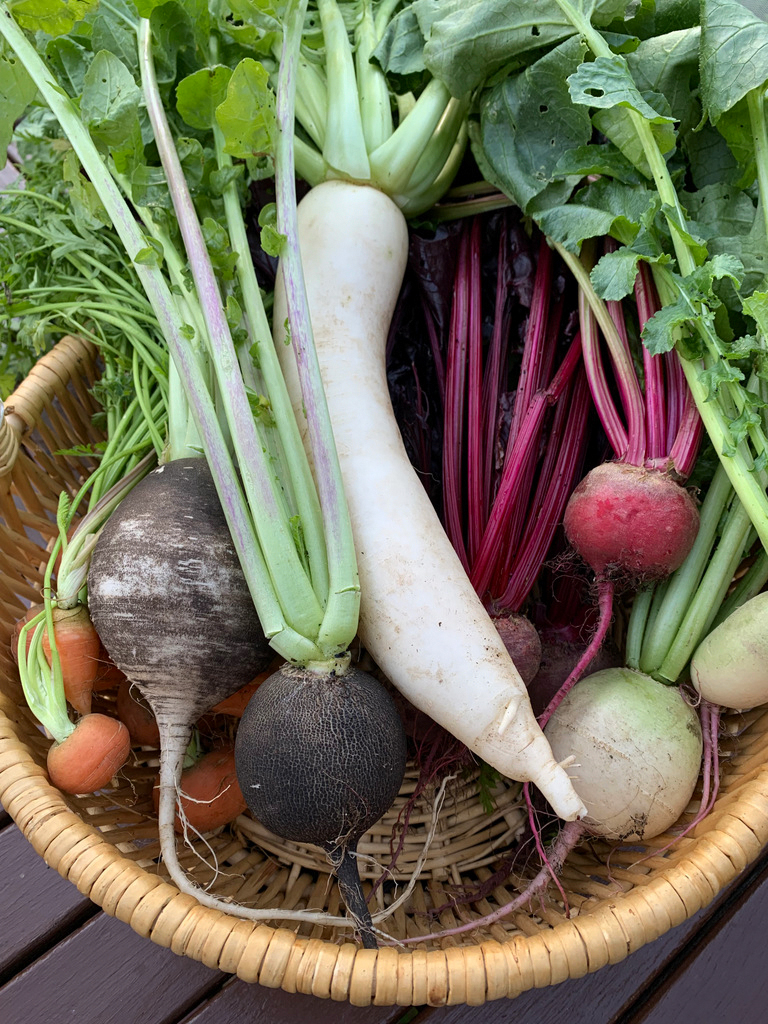If you’ve tried growing root vegetables and have been less than productive, you’re not alone. Follow these top tips for how to grow root vegetables successfully.

Root Vegetables: Carrots, Beetroot, Kohlrabi – Photo © The Gourmantic Garden
Root vegetables are those grown for their edible roots. Unlike other vegetables, root crops grow underground which means you can’t determine the extent of their growth until you harvest or feel around below the soil.

Daikon Radish, Paris Market Carrot, Spanish Black Radish, Watermelon Radish – Photo © The Gourmantic Garden
Root vegetables come in different categories:
- taproots (carrot, beetroot, radish, parsnips, turnips, kohlrabi)
- tubers (potato, sweet potato, yam, horseradish)
- bulbs (onion, garlic)
- rhizomes (ginger, turmeric)
How to Grow Root Vegetables Successfully

Tips for Growing Root Vegetables – Photo © The Gourmantic Garden
- Pick the Season: root vegetables favour cool weather so its best to sow seeds in autumn and in some climates, early spring.
- Prepare the Soil: Cultivate the soil well and remove any rocks or large roots. Add compost and a small amount of phosphorus to your soil to promote root growth. Check instructions on the packet for the amount.Avoid using fertilisers high in nitrogen as it will promote leaf growth at the expense of the root.
- Location: Root vegetables need full sun so pick a location that gets maximum amount of sunlight in the cooler months.
- Direct Sow: Most root vegetables do not survive a transplant so pick your location and sow seeds direct.
- Keep Moist: “Some gardeners then cover the pre-moistened, sown row with row-cover fabric or even a piece of burlap or grass clippings to keep the moisture in while awaiting seedling emergence.”
- Seed Spacing: Follow the recommended seed spacing on the packets to avoid thinning out later. This is a personal preference and I would rather not waste seeds. You can use pelleted seeds which are normal seeds that have been coated to make them easier to handle.
- Consistent Watering: Keep the soil consistently moist but not too wet or too dry.
- Feeding: A fortnightly dose of seaweed solution helps to promote strong roots. Again, don’t use fertilisers high in nitrogen as you will end up with leaf growth at the expense of the roots.
- Harvest as you Need: Harvest the largest vegetables first leaving the smaller crops in to mature further. It’s best to harvest as you need to use them and if left in the ground for too long and they get woody, let them go to seed for subsequent planting.
- Remove Leaves: Once you’ve harvested your root vegetables, separate the leaves from the roots. Not only are they edible, this is to ensure the root retains its moisture rather than feed it back to the leaves.
Another tip is to practice succession planting by staggering your sowing during the growing season to ensure a continual harvest.
Want to Know More?
You’ll find more information on how to grow carrot, beetroot, radish, which varieties to try, how to pair it with food and spirits, and how to use them in cocktails including a full recipe in my 260+ page digital book GROW YOUR OWN COCKTAIL GARDEN available now.


